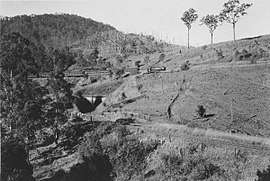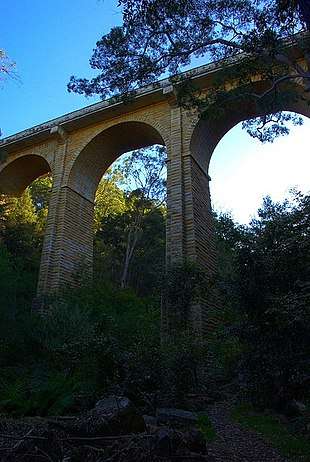Cougal Spiral
The Cougal Spiral is a heritage-listed single track railway tunnel and spiral feature of the North Coast railway line in Australia that connects New South Wales with Queensland through Richmond Gap in the Kyogle Council local government area of New South Wales, Australia. It was built during 1930. It is also known as the Border Loop railway formation and landscape, Cougal To Border Loop and Railway Spiral and Landscape. The property was added to the New South Wales State Heritage Register on 2 April 1999.[1]
 The Brisbane Mail crossing over No.1 Spiral Tunnel in 1940 | |
 Location on the border between New South Wales and Queensland | |
| Overview | |
|---|---|
| Official name | Border Loop railway formation and landscape |
| Other name(s) |
|
| Line | North Coast railway line |
| Location | Richmond Gap connecting New South Wales and Queensland, Australia |
| Coordinates | 28°21′16″S 152°57′51″E |
| Operation | |
| Opened | 29 August 1930 |
| Owner | Transport Asset Holding Entity |
| Operator | Australian Rail Track Corporation |
| Technical | |
| Length | A series of three tunnels:
|
| Track gauge | 4 ft 8 1⁄2 in (1,435 mm) standard gauge |
| Grade | 1.5% |
| Route map | |
.jpg) | |
| Official name | Border Loop railway formation and landscape; Cougal To Border Loop; Railway Spiral and Landscape |
| Type | State heritage (landscape) |
| Designated | 2 April 1999 |
| Reference no. | 1027 |
| Type | Historic Landscape |
| Category | Landscape - Cultural |
The railway line needs to climb at a steady ruling gradient from Kyogle to the summit at a tunnel at the border between the two states.[2] The border is also at the watershed.[3] The rail spiral and associated facilities are located between 871 and 876 kilometres (541 and 544 mi) from Sydney Central railway station.[1]
Description
Climbing almost non-stop at the ruling grade of 1 in 66 or 1.5% (compensated) the line has almost continuous curves of 240 m (790 ft) radius. Near Cougal, the alignment finally runs out of valley, and has nowhere to go. Fortunately a convenient hill allows the line to circle back on itself so that it climbs 30 metres (98 ft) without having to make any forward progress. Soon after the Border Tunnel under the watershed is reached the line descends on the other side. The spiral has two short tunnels, one where it passes under itself, plus another through a small spur in the hillside.
The tunnel at the border summit is approximately 1,600 metres (5,200 ft) long, broken up into three separate tunnels. A lower summit, perhaps without the spiral, would be possible with a considerably longer and more expensive summit tunnel, with the possibility of problems with fumes for both the original steam locomotives and the replacement diesel engines.
The Cougal Spiral is easily viewed from parts of the Lions Road. The structure has been heritage listed due to its historical, scientific and architectural rarity. It opened on 29 August 1930 as part of the extension of the North Coast line from Kyogle to South Brisbane.[2]
The Cougal Railway Spiral and Landscape consists of the following elements:[1]
- an underbridge, constructed of five 20.12-metre (66.0 ft) steel spans RSJ on concrete piers, located at 873.217 kilometres (542.592 mi) from Central;
- a 192-metre (630 ft) concrete tunnel, located from 871.947 to 872.139 kilometres (541.803 to 541.922 mi) from Central;
- a 177-metre (581 ft) concrete tunnel, located from 872.661 to 872.838 kilometres (542.246 to 542.356 mi) from Central;
- the Border Loop crossing, located at 875.110 kilometres (543.768 mi) from Central (no longer extant); and
- a 1,160-metre (3,810 ft) tunnel on the border with Queensland, located from 875.482 to 876.642 kilometres (543.999 to 544.720 mi) from Central.
The spiral is formed by the whole section of line from Cougal to the Border loop.[1]
History
The Border Loop opened on 29 August 1930, connecting NSW and Queensland by rail via Richmond Gap.[1]
Heritage listing
As at 19 July 2013, the Cougal to Border Loop section of the North Coast Line was a notable engineering achievement, revealing a twentieth century engineering solution that allows trains to pass through the steep topography at the NSW/Queensland border.[1]
Border Loop railway formation and landscape was listed on the New South Wales State Heritage Register on 2 April 1999 having satisfied the following criteria.[1]
The place is important in demonstrating the course, or pattern, of cultural or natural history in New South Wales.
The completion of the Cougal to Border Loop section of the North Coast Railway was a major engineering feat in the first half of the twentieth century, being one of several major engineering projects in NSW that allowed continuous railway access between Sydney and Brisbane.[1]
The place is important in demonstrating aesthetic characteristics and/or a high degree of creative or technical achievement in New South Wales.
The combination of tunnels, crossing loops, the underbridge and spiral together form a technically significant example of an innovative and successful railway engineering solution.[1]
The place possesses uncommon, rare or endangered aspects of the cultural or natural history of New South Wales.
The railway spiral at Border Loop is one of only two railway spirals in NSW.[1]
References
- "Border Loop railway formation and landscape". New South Wales State Heritage Register. Office of Environment and Heritage. H01027. Retrieved 2 June 2018.
- "Cougal To Border Loop, Railway Spiral and Landscape". New South Wales State Heritage Register. Office of Environment and Heritage. Retrieved 11 September 2017.
- "A Railway Spiral". The Sydney Morning Herald. 24 September 1930. p. 12.
Attribution
![]()
External links
![]()
